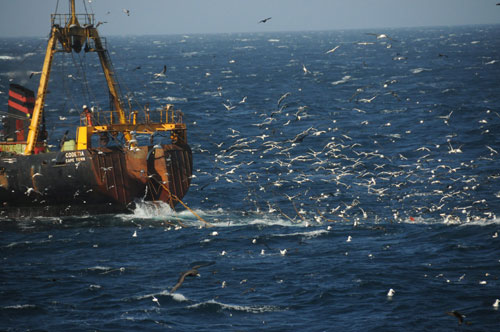Two recent publications in the African Journal of Marine Science quantify seabird bycatch in southern African longline fisheries. The details below have been summarized from the papers' abstracts. The two publications emanate from Dr Samantha Petersen's PhD research at the University of Cape Town.
The waters around South Africa support a pelagic longline fleet targeting tunas Thunnus spp. and swordfish Xiphias gladius. Fisheries observers collected seabird bycatch data from 2 256 sets (4.4 million hooks) and recorded a total of 1 954 birds of 11 seabird species, eight of which are considered threatened. Birds were caught at an average rate of 0.44 per 1 000 hooks, resulting in an average of 2 900 seabirds killed a year, decreasing from approximately 5 900 in 1998 to 1 800 in 2005. Estimates of the numbers of seabirds killed per year were lower than in other studies, an improvement most likely linked to the termination of foreign bilateral agreements, as well as to improved awareness among fishers as a result of ongoing education campaigns. Some of the apparent decreases in catch rate could reflect reduced numbers of seabirds at sea, the result of ongoing population decreases in several key species.

Seabird bycatch in the demersal longline hake (Merluccius capensis and M. paradoxus) fishery in the southern Benguela region was recorded from 2 412 sets (14 million hooks). Of the 107 seabirds caught, at a rate of 0.008 per 1 000 hooks, 41 were killed (0.003 per 1 000 hooks). There was a significant decrease in catch rate from 2000 to 2006. An estimated 225 birds were killed a year by the South African fishery. The White-chinned Petrel Procellaria aequinoctialis was the species most commonly caught by the South African fleet. Seabird bycatch in the Namibian demersal longline fishery was estimated at 0.05-0.13 birds per 1 000 hooks. The South African hake longline fishery has a relatively small impact on pelagic seabird populations compared with the Namibian fishery.
References:
Petersen, S.L., Honig, M.B., Ryan, P.G. & Underhill, L.G. 2009. Seabird bycatch in the pelagic longline fishery off southern Africa. African Journal of Marine Science 31: 191-204. (click here for full abstract)
Petersen, S.L., Honig, M.B., Ryan, P.G., Underhill, L.G. & Goren, M. 2009. Seabird bycatch in the demersal longline fishery off southern Africa. African Journal of Marine Science 31: 205-214. (click here for full abstract).
John Cooper, ACAP Information Officer, 12 December 2009

 English
English  Français
Français  Español
Español